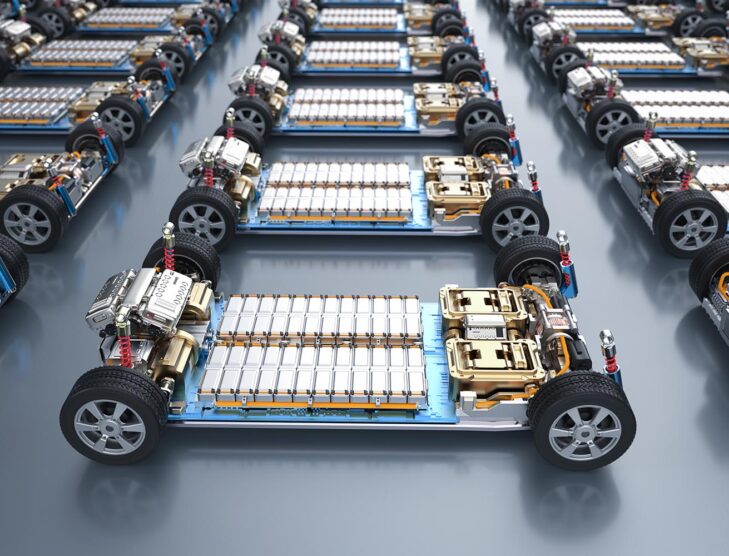
Exploring the environmental footprint of electric vehicles
In the era of electric vehicles (EVs), it is important to remember that these cars and trucks are only as clean as the energy that powers them. EVs have the potential to offer a more environmentally friendly transport solution, although their performance relies heavily on the source of the electricity. Renewable energy derived from wind and solar can maximise environmental benefits. Nevertheless, many governments are pushing hard for EVs despite the poor carbon dioxide (CO2) footprint of their electricity generation.

Abundant sources of renewable energy are at our fingertips and the potential of wind and solar power is virtually limitless. Still, of the around 170,000 terawatt-hours (TWh) of energy from all sectors on our planet, just 15% is obtained from renewable sources and an increase in global energy demand is an ever-present challenge. The production and consumption of renewable energy needs to increase drastically to solve the problem we face, says Marc Sens, senior vice president, Research & Technology/Sustainable Solutions at IAV GmbH.
Sens joined IAV GmbH in 1998 as a development engineer for Engine Mechanics. IAV GmbH (Ingenieurgesellschaft Auto und Verkehr) is a German engineering company specialising in the automotive industry. Founded in 1983 as a spin-off from the Technical University of Berlin, IAV has grown into one of the leading global engineering service providers in the automotive sector. The company is known for its expertise in the development, optimisation and testing of all types of powertrain systems, including those for conventional internal combustion engines, hybrids, and electric vehicles.
Speaking in the Executives Panel at the 2023 JSAE/SAE Powertrains, Energy & Lubricants International Meeting in Kyoto, Japan, on “Technologies and Scenarios to Achieve a Rapid Reduction of the Global Warming Potential of the Transport Sector,” Sens outlined a significant mismatch between renewable energy availability and our transportation requirements.
Transport alone required around 34,000 TWh in 2022, with around 28,000 TWh stemming from the road transport sector. A paltry 3,700 TWh of electricity was produced by wind and solar globally in 2022—around 10% of transportation requirements (or around 15% of road transport needs).

Electricity continues to be generated largely from fossil fuels such as coal, natural gas and oil—meaning EVs do not deliver the zero emissions we are so often led to believe. Sens emphasised the importance of producing renewable energy where solar and wind sources are massively (and easily) available. Unfortunately, this is often in areas where the population is very low—adding complexity to energy storage and transportation. There are multiple possibilities for energy carriage including batteries, ammonia, synthetic fuels, hydrogen and more. However, the achievable energy density will decide which of the aforementioned are most meaningful in the future and so far batteries are not relevant for high-density energy carriage over long distances.
From 2000 to 2022 the global electricity intensity was optimised by just 7%. The intensity is not expected to decrease dramatically based on current assumptions, says Sens. The reality is we won’t have 100% renewable energy any time soon, he says. Sens highlighted a prediction by the International Energy Agency (IEA) that in 2040 more coal will be employed to generate electricity than in 2018. Some countries will reduce coal deployment massively; however, others will increase significantly in order to fulfil their energy demand.
The slow optimisation of electricity intensity reinforces the need to continue working on the optimisation of the internal combustion engine (ICE), says Sens. We need all options to de-fossilise the transport sector and cannot rely on one single source, he says. Several options are available that can contribute to a massive reduction of CO2 in the transport sector, although Sens noted that restrictions or bans of feasible and helpful technologies are not beneficial at all.
Sustainability assessments should not work with the mean value for energy provision, but instead with the footprint of the extra electricity, which is often based on fossil fuels, says Sens. The global mean CO2 footprint for each kilowatt-hour (kWh) of produced electricity in 2022 was 436 grams of CO2 equivalent (gCO2-eq/kWh). In China, where EVs are a significant focus, it is 531 gCO2-eq/kWh and in India 632 gCO2-eq/KWh.
Sens outlined a simple assessment of a compact battery electric vehicle (BEV) SUV, with a wheel energy for propelling the vehicle of around 15 kWh and 85% powertrain efficiency, using the global mean electricity intensity of 436 gCO2-eq/kWh. The research delivered CO2-eq emissions of 84 grams per kilometre. The same-sized ICE propelled by fossil fuels produced 185 gCO2-eq per km. BEV’s demonstrated a distinct advantage over the fossil fuel equivalent.
However, Sens detailed significant opportunities with series hybrid vehicles—also known as range-extended electric vehicles (REEV). A series hybrid operating on fossil fuels with an effective mean ICE efficiency of 40% produced around 130 gCO2-eq/km—a similar figure to an EV in India (127 gCO2-eq/km) based on India’s mean electricity intensity.

Sens also presented the results of a smart life cycle assessment (LCA) during the Executive Panel Session at the Kyoto event. IAV studied a compact class vehicle—similar to a Tesla Y or Volkswagen ID.4—and applied the global mean electricity mix forecasted for 2030 (330 gCO2-eq/kWh). The research included a variation of battery size based on a NMC (Nickel Manganese Cobalt) cathode-based chemistry and assessed both fossil fuels and renewable fuels for the ICE with their impact on the Global Warming Potential (GWP). Production, usage and recycling were all considered as part of the evaluation. The following CO2-eq values are those representing the cradle-to-grave value impact.
An ICE powertrain running on fossil fuels with a 40% peak efficiency produced 179 gCO2-eq/km, whereas a pure BEV with a 100 kWh battery capacity gave 139 gCO2-eq./km cradle-to-grave. Improving the efficiency of the ICE alone provided a drastic reduction to 151 gCO2-eq. per km. The introduction of a series hybrid with a small battery (10 kWh) and operating on eFuels instead of fossil fuels delivered a step change—only 77 gCO2-eq per km. The series hybrid has an advantage over the BEV when fuelled with electricity from the global mean electricity mix, says Sens. The 10 kWh battery capacity would allow for a certain time to drive emission-free in dedicated areas.
Sens also outlined work IAV has undertaken with Chinese OEMs to optimise ICE efficiency by the introduction of an active pre-chamber spark plug. The IAV active pre-chamber solution enables the injection of air-fuel mixture into the pre-chamber to ensure optimal ignition conditions within the pre-chamber and support the ignition of highly diluted mixtures in the main combustion chamber. The work provides markable further improvements in efficiency and therefore additional CO2 reductions.
When it comes to renewable energy, it is not all about wind and solar power. Sens noted the huge potential for biofuels to contribute to massive reductions in CO2 in the transport sector. The IAV representative emphasised that methane engines offer the potential for peak break thermal efficiencies of 45%+. Biomethane’s low trade-off between global warming potential and primary energy demand in fuel production makes it an interesting option in the area of biofuels, he says.
Sens outlined a development effort with the company Gane Energy, which has intellectual property (IP) on a specific formulation of methanol-based fuel mixed with water. The aim is to use the methanol fuel in today’s diesel compression ignition vehicles without requiring significant changes to the engines.
The methanol-water mixture is tanked to the vehicle and there is a dimethyl ether (DME) on board production unit to allow the low-energy production of DME. DME is then used for supporting the compression ignition process with the engine. The two companies have converted a heavy-duty six-cylinder engine to methanol operation.
Sens noted that the combustion behaviour is the same as the base diesel engine, and equivalent (or better) efficiency can be achieved with the methanol engine concept.







